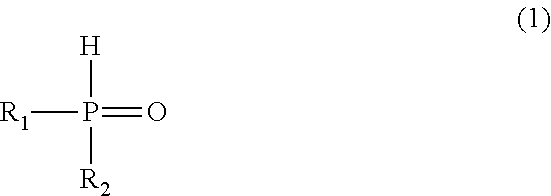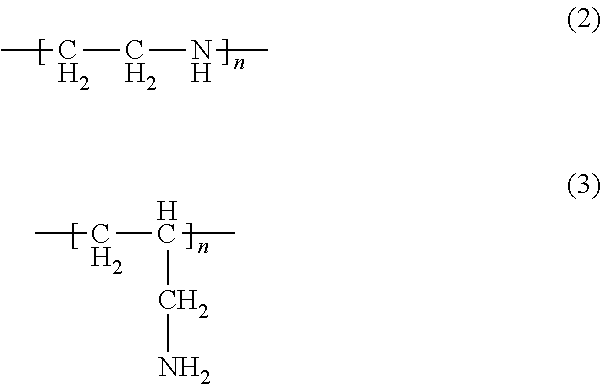Modified polyamine
a technology of polyamine and polyamine, applied in the field of modified polyamine, can solve the problems of color purity reduction, color change, and no description of heat resistance, and achieve the effects of reducing color purity, excellent heat resistance, and excellent pigment dispersion performance and resistance to thermal coloration
- Summary
- Abstract
- Description
- Claims
- Application Information
AI Technical Summary
Benefits of technology
Problems solved by technology
Method used
Image
Examples
production example 1
Preparation 1 of Polyester (PES-1)
[0075]To a reaction flask provided with a thermometer, a stirrer, a nitrogen introduction inlet, a reflux condenser, a water separator, and a decompression port, 30.0 parts of xylene (manufactured by Junsei Chemical Co., Ltd., hereinafter the same shall apply), 300.0 parts of 12-hydroxystearic acid (manufactured by Junsei Chemical Co., Ltd., hereinafter the same shall apply), and 0.1 parts of tetrabutyl titanate (manufactured by Tokyo Chemical Industry Co., Ltd., hereinafter the same shall apply) were fed, and the temperature was raised to 200° C. under a nitrogen stream over a period of 4 hours. The reaction mixture was further heated at 200° C. for 5 hours, and water generated during the heating reaction and xylene were distilled off. Thereafter, the reaction mixture was cooled to room temperature.
[0076]This reaction product is called Polyester PES-1. The Polyester PES-1 had a molecular weight of 1670 and an acid value of 33.5 mg KOH / g.
production example 2
Preparation 2 of Polyester (PES-2)
[0077]To the same reaction flask as in Production Example 1, 10.0 parts of 12-hydroxystearic acid, 190 parts of c-caprolactone (manufactured by Junsei Chemical Co., Ltd., hereinafter the same shall apply), and 0.1 parts of tetrabutyl titanate were fed, and the temperature was raised to 160° C. under a nitrogen stream over a period of 2 hours. The reaction mixture was heated at 160° C. for 4 hours, and then, the heating was continued until the residual amount of ε-caprolactone was decreased to 1% or less. Thereafter, the reaction mixture was cooled to room temperature.
[0078]This reaction product is called Polyester PES-2. The Polyester PES-2 had a molecular weight of 6230 and an acid value of 9.0 mg KOH / g.
production example 3
Preparation 3 of Polyester (PES-3)
[0079]To the same reaction flask as in Production Example 1, 5.0 parts of xylene, 15.5 parts of ethylene glycol (manufactured by Junsei Chemical Co., Ltd., hereinafter the same shall apply), 36.5 parts of adipic acid (manufactured by Junsei Chemical Co., Ltd., hereinafter the same shall apply), and 0.1 parts of tetrabutyl titanate were fed, and the temperature was raised to 160° C. under a nitrogen stream over a period of 4 hours. The reaction mixture was further heated at 160° C. for 2 hours. Water generated during the heating reaction and xylene were distilled off. Thereafter, the reaction mixture was cooled to room temperature.
[0080]This reaction product is called Polyester PES-3. The Polyester PES-3 had a molecular weight of 2610 and an acid value of 21.5 mg KOH / g.
PUM
| Property | Measurement | Unit |
|---|---|---|
| temperature | aaaaa | aaaaa |
| temperature | aaaaa | aaaaa |
| temperature | aaaaa | aaaaa |
Abstract
Description
Claims
Application Information
 Login to View More
Login to View More - R&D
- Intellectual Property
- Life Sciences
- Materials
- Tech Scout
- Unparalleled Data Quality
- Higher Quality Content
- 60% Fewer Hallucinations
Browse by: Latest US Patents, China's latest patents, Technical Efficacy Thesaurus, Application Domain, Technology Topic, Popular Technical Reports.
© 2025 PatSnap. All rights reserved.Legal|Privacy policy|Modern Slavery Act Transparency Statement|Sitemap|About US| Contact US: help@patsnap.com



